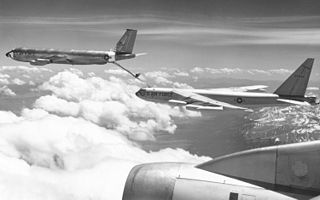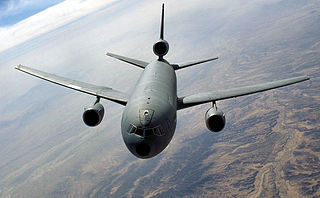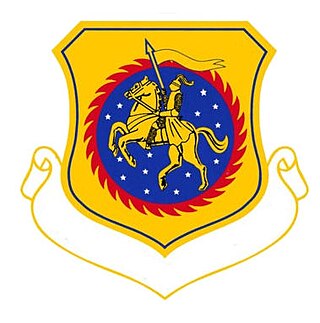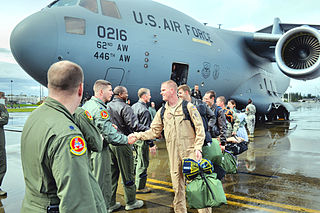
Royal Air Force Old Buckenham or more simply RAF Old Buckenham is a former Royal Air Force station located 2 miles (3.2 km) south east of Attleborough, Norfolk, England which was used during the Second World War by the United States for the strategic bombing campaign against Germany.

The 92d Operations Group is the flying component of the 92d Air Refueling Wing, assigned to the United States Air Force Air Mobility Command Eighteenth Air Force. The group is stationed at Fairchild Air Force Base, Washington.

The 462d Air Expeditionary Group is a provisional unit of the United States Air Force. It is assigned to Air Mobility Command to activate or inactivate as needed to meet operational requirements. Its last assignment was at Naval Support Facility Diego Garcia, British Indian Ocean Territory.

The 92nd Air Refueling Squadron, sometimes written as 92d Air Refueling Squadron, is a squadron of the 92nd Air Refueling Wing's 92nd Operations Group, stationed at Fairchild Air Force Base, Washington. It was first activated shortly before the entry of the United States into World War II as the 2nd Reconnaissance Squadron. After training in the Douglas B-18 Bolo in the southeastern United States, the squadron moved to the Pacific Coast after the Japanese attack on Pearl Harbor and participated in antisubmarine patrols with the Consolidated B-24 Liberator. In April 1942, it was redesignated the 392nd Bombardment Squadron. Starting in mid-1942, it also began training crews on the Liberator. It ended these operations in July 1943 and began to prepare for overseas movement. After three months of training, the squadron moved to the Central Pacific, where it flew its first combat mission in November. The 392nd continued combat operations until March 1945, when it was withdrawn and moved to Hawaii, where it conducted routine training and patrol operations until it was inactivated in November 1945.

The 96th Air Refueling Squadron was a unit of PACAF's 15th Wing at Joint Base Pearl Harbor–Hickam, Hawaii in partnership with the 203rd Air Refueling Squadron and 154th Maintenance Group of the Hawaii Air National Guard. It was inactivated on 3 September 2015.

The 97th Air Refueling Squadron is an active unit of the United States Air Force, stationed at Fairchild Air Force Base, Washington. It was most recently activated on 1 October 2019 and assigned to the 92nd Operations Group, 92nd Air Refueling Wing.

The 344th Air Refueling Squadron is a unit of the US Air Force, part of the 22d Air Refueling Wing of Air Mobility Command at McConnell Air Force Base, Kansas. It operates the Boeing KC-46 Pegasus aircraft conducting aerial refueling missions.

The 349th Air Refueling Squadron is a unit of the US Air Force, part of the 22d Air Refueling Wing at McConnell Air Force Base, Kansas. It operates the Boeing KC-135 Stratotanker aircraft conducting aerial refueling missions.

The 384th Air Refueling Squadron is an active United States Air Force unit, stationed at Fairchild Air Force Base, Washington, where it is assigned to the 92d Operations Group and operates the Boeing KC-135 Stratotanker aircraft conducting air refueling missions.

The 482d Operations Group is a United States Air Force Reserve unit assigned to the 482d Fighter Wing. It is stationed at Homestead Air Reserve Base, Florida.

The 305th Operations Group is a United States Air Force unit assigned to the 305th Air Mobility Wing. It is stationed at the McGuire AFB entity of Joint Base McGuire-Dix-Lakehurst, New Jersey.

The 452d Operations Group is the flying component of the 452d Air Mobility Wing, assigned to the United States Air Force Reserve. The group is stationed at March Air Reserve Base, California.

The 319th Operations Group is a United States Air Force unit assigned to 319th Reconnaissance Wing, Air Combat Command. It is stationed at Grand Forks Air Force Base, North Dakota operating RQ-4 Global Hawk remotely piloted aircraft (RPA) in the intelligence, surveillance and reconnaissance (ISR) role.

The 325th Weapons Squadron is a United States Air Force unit assigned to the USAF Weapons School, stationed at Whiteman Air Force Base, Missouri, it is a geographically separated unit of the 57th Wing at Nellis Air Force Base, Nevada. The mission of the squadron is to provide Northrop Grumman B-2 Spirit instructional flying.

The 98th Air Refueling Squadron is an inactive United States Air Force unit. Its last assignment was with the 92d Operations Group at Fairchild Air Force Base, Washington, where it was inactivated on 1 July 1998.

The 732d Bombardment Squadron is a former United States Army Air Forces unit. It was assigned to the 453d Bombardment Group and last stationed at Fort Dix Army Air Base, New Jersey, where it was inactivated on 12 September 1945. The squadron was first activated in May 1943. After training in the United States with the Consolidated B-24 Liberator, the squadron deployed to the European Theater of Operations, participating in the strategic bombing campaign against Germany. Following V-E Day, the squadron returned to the United States for conversion as a very heavy bomber unit for further service in the Pacific, but was inactivated after the surrender of Japan.

The 733d Bombardment Squadron is a former United States Army Air Forces unit. It was assigned to the 453d Bombardment Group and last stationed at Fort Dix Army Air Base, New Jersey, where it was inactivated on 12 September 1945. The squadron was first activated in May 1943. After training in the United States with the Consolidated B-24 Liberator, the squadron deployed to the European Theater of Operations, participating in the strategic bombing campaign against Germany. Following V-E Day, the squadron returned to the United States for conversion as a very heavy bomber unit, but inactivated instead.

The 734th Bombardment Squadron is a former United States Army Air Forces unit. It was assigned to the 453d Bombardment Group and last stationed at Fort Dix Army Air Base, New Jersey, where it was inactivated on 12 September 1945. The squadron was first activated in May 1943. After training in the United States with the Consolidated B-24 Liberator, the squadron deployed to the European Theater of Operations, participating in the strategic bombing campaign against Germany. Following V-E Day, the squadron returned to the United States for conversion as a very heavy bomber unit, but inactivated instead.

The 735th Bombardment Squadron is a former United States Army Air Forces unit. It was assigned to the 453d Bombardment Group and last stationed at Fort Dix Army Air Base, New Jersey, where it was inactivated on 12 September 1945. The squadron was first activated in May 1943. After training in the United States with the Consolidated B-24 Liberator, the squadron deployed to the European Theater of Operations, participating in the strategic bombing campaign against Germany. Following V-E Day, the squadron returned to the United States for conversion as a very heavy bomber unit, but inactivated instead.

The 817th Expeditionary Airlift Squadron is a provisional United States Air Force unit, assigned to Air Mobility Command to activate or inactivate as needed. It engaged in combat operations in Southwest Asia.





















